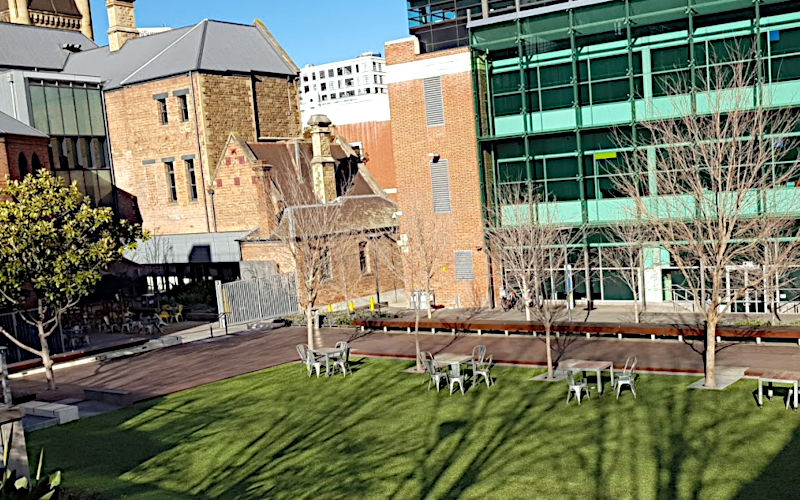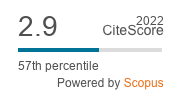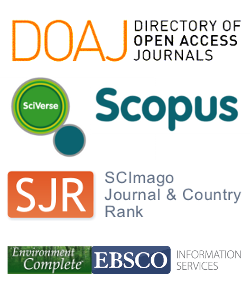Perceptions and Preferences of Urban Greenspaces: A Literature Review and Framework for Policy and Practice
DOI:
https://doi.org/10.3097/LO.201861Keywords:
greenspace, parks, lived experiences, livability, literature reviewAbstract
The ever-increasing process of urbanisation across the globe has major implications for the environment, biodiversity and health and wellbeing of urbanites. Urban greenspaces are considered a promising planning tool in tackling some of the problems associated with urbanisation such as pollution and urban heat island effects. It is, therefore, important to understand what encourages the extent to which urban dwellers interact with or use greenspaces. Perceptions and preferences are different ways of exploring how users interact with greenspace, but they are traditionally considered separately in extant research. The aim of this literature review is to synthesise the existing evidence for both perceptions of and preferences for greenspaces, highlighting crossovers and synergies between these two approaches. Drawing on a review of literature found in three online databases — EBSCOhost Web, Taylor and Francis Online and Elsevier —, the paper proposes a framework for understanding perceptions of and preferences for greenspaces which can assist policy makers and planners to develop and design greenspaces with higher efficiency and use or improve existing ones, ultimately improving the liveability of urban environments.
References
Adegun, O. B. (2018). Residents’ relationship with green infrastructure in cosmo city, johannesburg. Journal of Urbanism, 11(3), 329-346. doi:10.1080/17549175.2018.1470103
Alcock, I., White, M. P., Wheeler, B. W., Fleming, L. E., & Depledge, M. H. (2014). Longitudinal effects on mental health of moving to greener and less green urban areas. Environmental Science and Technology, 48(2), 1247-1255. doi:10.1021/es403688w
Arnberger, A., & Eder, R. (2015). Are urban visitors' general preferences for green-spaces similar to their preferences when seeking stress relief? Urban Forestry and Urban Greening, 14(4), 872-882. doi:10.1016/j.ufug.2015.07.005
Bazeley, P., & Richards, L. (2000). The NVivo Qualitative Project Book,
Bedimo-Rung, A. L., Mowen, A. J., & Cohen, D. A. (2005). The significance of parks to physical activity and public health: A conceptual model. American Journal of Preventive Medicine, 28(2 SUPPL. 2), 159-168. doi:10.1016/j.amepre.2004.10.024
Bell, S., Thompson, C. W., & Travlou, P. (2003). Contested views of freedom and control: Children, teenagers and urban fringe woodlands in central scotland. Urban Forestry and Urban Greening, 2(2), 87-100. doi:10.1078/1618-8667-00026
Bixler, R. D., & Floyd, M. F. (1997). Nature is scary, disgusting, and uncomfortable. Environment and Behavior, 29(4), 443-467. doi:10.1177/001391659702900401
Bjerke, T., Østdahl, T., Thrane, C., & Strumse, E. (2006). Vegetation density of urban parks and perceived appropriateness for recreation. Urban Forestry and Urban Greening, 5(1), 35-44. doi:10.1016/j.ufug.2006.01.006
Buchel, S., & Frantzeskaki, N. (2015). Citizens' voice: A case study about perceived ecosystem services by urban park users in rotterdam, the netherlands. Ecosystem Services, 12, 169-177. doi:10.1016/j.ecoser.2014.11.014
Buijs, A. E., Elands, B. H. M., & Langers, F. (2009). No wilderness for immigrants: Cultural differences in images of nature and landscape preferences. Landscape and Urban Planning, 91(3), 113-123. doi:10.1016/j.landurbplan.2008.12.003
Burgess, J., Harrison, C. M., & Limb, M. (1988). People, parks and the urban green: A study of popular meanings and values for open spaces in the city. Urban Studies, 25(6), 455-473. doi:10.1080/00420988820080631
Carter, M., & Horwitz, P. (2014). Beyond proximity: The importance of green space useability to self-reported health. EcoHealth, 11(3), 322-332. doi:10.1007/s10393-014-0952-9
Caula, S., Hvenegaard, G. T., & Marty, P. (2009). The influence of bird information, attitudes, and demographics on public preferences toward urban green spaces: The case of montpellier, france. Urban Forestry and Urban Greening, 8(2), 117-128. doi:10.1016/j.ufug.2008.12.004
Chen, B., Adimo, O. A., & Bao, Z. (2009). Assessment of aesthetic quality and multiple functions of urban green space from the users' perspective: The case of hangzhou flower garden, china. Landscape and Urban Planning, 93(1), 76-82. doi:10.1016/j.landurbplan.2009.06.001
Cohen, D. A., Han, B., Derose, K. P., Williamson, S., Marsh, T., Rudick, J., & McKenzie, T. L. (2012). Neighborhood poverty, park use, and park-based physical activity in a southern california city. Social Science and Medicine, 75(12), 2317-2325. doi:10.1016/j.socscimed.2012.08.036
Conedera, M., Del Biaggio, A., Seeland, K., Moretti, M., & Home, R. (2015). Residents' preferences and use of urban and peri-urban green spaces in a swiss mountainous region of the southern alps. Urban Forestry and Urban Greening, 14(1), 139-147. doi:10.1016/j.ufug.2015.01.003
de la Barrera, F., Reyes-Paecke, S., Harris, J., Bascuñán, D., & Farías, J. M. (2016). People's perception influences on the use of green spaces in socio-economically differentiated neighborhoods. Urban Forestry and Urban Greening, 20, 254-264. doi:10.1016/j.ufug.2016.09.007
de Vries, S., Verheij, R. A., Groenewegen, P. P., & Spreeuwenberg, P. (2003). Natural environments - healthy environments? an exploratory analysis of the relationship between greenspace and health. Environment and Planning A, 35(10), 1717-1731. doi:10.1068/a35111
Dehring, C., & Dunse, N. (2006). Housing density and the effect of proximity to public open space in aberdeen, scotland. Real Estate Economics, 34(4), 553-566. doi:10.1111/j.1540-6229.2006.00178.x
Douglas, O., Russell, P., & Scott, M. (2019). Positive perceptions of green and open space as predictors of neighbourhood quality of life: Implications for urban planning across the city region. Journal of Environmental Planning and Management, 62(4), 626-646. doi:10.1080/09640568.2018.1439573
Edwards, D., & Weldon, S. (2006). Race Equality and the Forestry Commission,
Ellaway, A., & Macintyre, S. (2001). Women in their place: Gender and perceptions of neighbourhoods and health in the west of scotland. Gender Differences in the Associations between Health and Neighbourhood Environment, 60, 1681-1692.
Ezzy, D. (2002). Qualitative Analysis: Practice and Innovation,
Farahani, L. M., & Maller, C. (2018). Investigating residents' use and perceptions of informal greenspaces: A study of stony creek in melbourne's wes. Paper Presented at the Conference: State of Australian Cities National Conference,
Farahani, L. M., Maller, C., & Phelan, K. (2018). Private Gardens as Urban Greenspaces: Can they Compensate for Poor Greenspace Access in Lower Socioeconomic Neighbourhoods?,
Gidlow, C. J., Ellis, N. J., & Bostock, S. (2012). Development of the neighbourhood green space tool (NGST). Landscape and Urban Planning, 106(4), 347-358. doi:10.1016/j.landurbplan.2012.04.007
Giles-Corti, B., Broomhall, M. H., Knuiman, M., Collins, C., Douglas, K., Ng, K., . . . Donovan, R. J. (2005). Increasing walking: How important is distance to, attractiveness, and size of public open space? American Journal of Preventive Medicine, 28(2 SUPPL. 2), 169-176. doi:10.1016/j.amepre.2004.10.018
Gobster, P. H. (1998). Urban parks as green walls or green magnets? interracial relations in neighborhood boundary parks. Landscape and Urban Planning, 41(1), 43-55. doi:10.1016/S0169-2046(98)00045-0
Gobster, P. H., & Westphal, L. M. (2004). The human dimensions of urban greenways: Planning for recreation and related experiences. Landscape and Urban Planning, 68(2-3), 147-165. doi:10.1016/S0169-2046(03)00162-2
Gómez, E., & Malega, R. (2007). Residential attributes, park use, and perceived benefits: An exploration of individual and neighbourhood characteristics. Leisure/ Loisir, 31(1), 77-104. doi:10.1080/14927713.2007.9651374
Grahn, P., & Stigsdotter, U. A. (2003). Landscape planning and stress. Urban Forestry and Urban Greening, 2(1), 1-18. doi:10.1078/1618-8667-00019
Grahn, P., & Stigsdotter, U. K. (2010). The relation between perceived sensory dimensions of urban green space and stress restoration. Landscape and Urban Planning, 94(3-4), 264-275. doi:10.1016/j.landurbplan.2009.10.012
Gramann, J. H., Floyd, M. F., & Saenz, R. (2019). Outdoor recreation and mexican american ethnicity: A benefits perspective. Culture, conflict, and communication in the wildland-urban interface (pp. 69-84) doi:10.4324/9780429041372-7
Groenewegen, P. P., Van Den Berg, A. E., De Vries, S., & Verheij, R. A. (2006). Vitamin G: Effects of green space on health, well-being, and social safety. BMC Public Health, 6 doi:10.1186/1471-2458-6-149
Hadavi, S., Kaplan, R., & Hunter, M. C. R. (2015). Environmental affordances: A practical approach for design of nearby outdoor settings in urban residential areas. Landscape and Urban Planning, 134, 19-32. doi:10.1016/j.landurbplan.2014.10.001
Hitchings, R. (2013). Studying the preoccupations that prevent people from going into green space. Landscape and Urban Planning, 118, 98-102. doi:10.1016/j.landurbplan.2012.09.006
Jansson, M., Fors, H., Lindgren, T., & Wiström, B. (2013). Perceived personal safety in relation to urban woodland vegetation - A review. Urban Forestry and Urban Greening, 12(2), 127-133. doi:10.1016/j.ufug.2013.01.005
Jay, M., & Schraml, U. (2014). Diversity in mind: Towards a differentiated understanding of migrants' recreational practices in urban forests. Urban Forestry and Urban Greening, 13(1), 38-47. doi:10.1016/j.ufug.2013.10.001
Jay, M., & Schraml, U. (2009). Understanding the role of urban forests for migrants - uses, perception and integrative potential. Urban Forestry and Urban Greening, 8(4), 283-294. doi:10.1016/j.ufug.2009.07.003
Jim, C. Y., & Chen, W. Y. (2006). Perception and attitude of residents toward urban green spaces in guangzhou (china). Environmental Management, 38(3), 338-349. doi:10.1007/s00267-005-0166-6
Jim, C. Y., & Shan, X. (2013). Socioeconomic effect on perception of urban green spaces in guangzhou, china. Cities, 31, 123-131. doi:10.1016/j.cities.2012.06.017
Jorgensen, A., Hitchmough, J., & Calvert, T. (2002). Woodland spaces and edges: Their impact on perception of safety and preference. Landscape and Urban Planning, 60(3), 135-150. doi:10.1016/S0169-2046(02)00052-X
Kabisch, N., Qureshi, S., & Haase, D. (2015). Human-environment interactions in urban green spaces - A systematic review of contemporary issues and prospects for future research. Environmental Impact Assessment Review, 50, 25-34. doi:10.1016/j.eiar.2014.08.007
Kaczynski, A. T., Potwarka, L. R., Smale, B. J. A., & Havitz, M. F. (2009). Association of parkland proximity with neighborhood and park-based physical activity: Variations by gender and age. Leisure Sciences, 31(2), 174-191. doi:10.1080/01490400802686045
Kaplan, R., & Kaplan, S. (1989). The experience of nature: A psychological perspective. The Experience of Nature,
Kaplan, S. (1995). The restorative benefits of nature: Toward an integrative framework. Journal of Environmental Psychology, 15(3), 169-182. doi:10.1016/0272-4944(95)90001-2
Keith, S. J., Larson, L. R., Shafer, C. S., Hallo, J. C., & Fernandez, M. (2018). Greenway use and preferences in diverse urban communities: Implications for trail design and management. Landscape and Urban Planning, 172, 47-59. doi:10.1016/j.landurbplan.2017.12.007
Kemperman, A., & Timmermans, H. (2006). Preferences, benefits, and park visits: A latent class segmentation analysis. Tourism Analysis, 11(4), 221-230.
Kendal, D., Williams, N. S. G., & Williams, K. J. H. (2012). Drivers of diversity and tree cover in gardens, parks and streetscapes in an australian city. Urban Forestry and Urban Greening, 11(3), 257-265. doi:10.1016/j.ufug.2012.03.005
Keniger, L. E., Gaston, K. J., Irvine, K. N., & Fuller, R. A. (2013). What are the benefits of interacting with nature? International Journal of Environmental Research and Public Health, 10(3), 913-935. doi:10.3390/ijerph10030913
Kienast, F., Degenhardt, B., Weilenmann, B., Wäger, Y., & Buchecker, M. (2012). GIS-assisted mapping of landscape suitability for nearby recreation. Landscape and Urban Planning, 105(4), 385-399. doi:10.1016/j.landurbplan.2012.01.015
Kong, F., Yin, H., Nakagoshi, N., & Zong, Y. (2010). Urban green space network development for biodiversity conservation: Identification based on graph theory and gravity modeling. Landscape and Urban Planning, 95(1-2), 16-27. doi:10.1016/j.landurbplan.2009.11.001
Koppen, G., Sang, T. O., & Tveit, M. S. (2014). Managing the potential for outdoor recreation: Adequate mapping and measuring of accessibility to urban recreational landscapes. Urban Forestry and Urban Greening, 13(1), 71-83. doi:10.1016/j.ufug.2013.11.005
Lee, A. C. K., & Maheswaran, R. (2011). The health benefits of urban green spaces: A review of the evidence. Journal of Public Health, 33(2), 212-222. doi:10.1093/pubmed/fdq068
Lin, B. B., Fuller, R. A., Bush, R., Gaston, K. J., & Shanahan, D. F. (2014). Opportunity or orientation? who uses urban parks and why. PLoS ONE, 9(1) doi:10.1371/journal.pone.0087422
Loewen, L. J., Steel, G. D., & Suedfeld, P. (1993). Perceived safety from crime in the urban environment. Journal of Environmental Psychology, 13(4), 323-331. doi:10.1016/S0272-4944(05)80254-3
Loukaitou-Sideris, A. (1995). Urban form and social context: Cultural differentiation in the uses of urban parks. Journal of Planning Education and Research, 14(2), 89-102. doi:10.1177/0739456X9501400202
Loukaitou-Sideris, A., Levy-Storms, L., Chen, L., & Brozen, M. (2016). Parks for an aging population: Needs and preferences of low-income seniors in los angeles. Journal of the American Planning Association, 82(3), 236-251. doi:10.1080/01944363.2016.1163238
Madureira, H., Nunes, F., Oliveira, J. V., Cormier, L., & Madureira, T. (2015). Urban residents' beliefs concerning green space benefits in four cities in france and portugal. Urban Forestry and Urban Greening, 14(1), 56-64. doi:10.1016/j.ufug.2014.11.008
Maller, C., & Farahani, L. (2018). Snakes in the city: Understanding urban residents’ responses to greening interventions for biodiversity. State of Australian Cities National Conference (SOAC 2017), , 1-10.
Marcus, C. C., & Francis, C. (1998). People Places: Design Guidelines for Urban Open Space,
Mowen, A. J., Payne, L. L., & Scott, D. (2005). Change and stability in park visitation constraints revisited. Leisure Sciences, 27(2), 191-204. doi:10.1080/01490400590912088
Ode Sang, Å., Knez, I., Gunnarsson, B., & Hedblom, M. (2016). The effects of naturalness, gender, and age on how urban green space is perceived and used. Urban Forestry and Urban Greening, 18, 268-276. doi:10.1016/j.ufug.2016.06.008
Ode, A., Fry, G., Tveit, M. S., Messager, P., & Miller, D. (2009). Indicators of perceived naturalness as drivers of landscape preference. Journal of Environmental Management, 90(1), 375-383. doi:10.1016/j.jenvman.2007.10.013
Özgüner, H. (2011). Cultural differences in attitudes towards urban parks and green spaces. Landscape Research, 36(5), 599-620. doi:10.1080/01426397.2011.560474
Özgüner, H., & Kendle, A. D. (2006). Public attitudes towards naturalistic versus designed landscapes in the city of sheffield (UK). Landscape and Urban Planning, 74(2), 139-157. doi:10.1016/j.landurbplan.2004.10.003
Payne, L. L., Mowen, A. J., & Orsega-Smith, E. (2002). An examination of park preferences and behaviors among urban residents: The role of residential location, race and age. Leisure Sciences, 24(2), 181-198. doi:10.1080/01490400252900149
Peschardt, K. K., & Stigsdotter, U. K. (2013). Associations between park characteristics and perceived restorativeness of small public urban green spaces. Landscape and Urban Planning, 112(1), 26-39. doi:10.1016/j.landurbplan.2012.12.013
Peters, K., Elands, B., & Buijs, A. (2010). Social interactions in urban parks: Stimulating social cohesion? Urban Forestry and Urban Greening, 9(2), 93-100. doi:10.1016/j.ufug.2009.11.003
Peterson, G. L., Peterson, G. L., Dwyer, J. F., & Darragh, A. J. (1983). A behavioral urban recreation site choice model. Leisure Sciences, 6(1), 61-81. doi:10.1080/01490408309513022
Pillay, S., & Pahlad, R. (2014). A gendered analysis of community perceptions and attitudes towards green spaces in a durban metropolitan residential area: Implications for climate change mitigation. Agenda (Durban, South Africa), 28(3), 168-178.
Qiu, L., Lindberg, S., & Nielsen, A. B. (2013). Is biodiversity attractive?-on-site perception of recreational and biodiversity values in urban green space. Landscape and Urban Planning, 119, 136-146. doi:10.1016/j.landurbplan.2013.07.007
Qiu, L., & Nielsen, A. B. (2015). Are perceived sensory dimensions a reliable tool for urban green space assessment and planning? Landscape Research, 40(7), 834-854. doi:10.1080/01426397.2015.1029445
Qureshi, S., Breuste, J. H., & Jim, C. Y. (2013). Differential community and the perception of urban green spaces and their contents in the megacity of karachi, pakistan. Urban Ecosystems, 16(4), 853-870. doi:10.1007/s11252-012-0285-9
Qureshi, S., Breuste, J. H., & Lindley, S. J. (2010). Green space functionality along an urban gradient in karachi, pakistan: A socio-ecological study. Human Ecology, 38(2), 283-294. doi:10.1007/s10745-010-9303-9
Rishbeth, C., & Finney, N. (2006). Novelty and nostalgia in urban greenspace: Refugee perspectives. Tijdschrift Voor Economische En Sociale Geografie, 97(3), 281-295. doi:10.1111/j.1467-9663.2006.00520.x
Rodiek, S. (2002). Influence of an outdoor garden on mood and stress in older persons. Journal of Therapeutic Horticulture, 13(1), 13-21.
Rossi, S. D., Byrne, J. A., Pickering, C. M., & Reser, J. (2015). 'Seeing red' in national parks: How visitors' values affect perceptions and park experiences. Geoforum, 66, 41-52. doi:10.1016/j.geoforum.2015.09.009
Sanesi, G., & Chiarello, F. (2006). Residents and urban green spaces: The case of bari. Urban Forestry and Urban Greening, 4(3-4), 125-134. doi:10.1016/j.ufug.2005.12.001
Schetke, S., Qureshi, S., Lautenbach, S., & Kabisch, N. (2016). What determines the use of urban green spaces in highly urbanized areas? - examples from two fast growing asian cities. Urban Forestry and Urban Greening, 16, 150-159. doi:10.1016/j.ufug.2016.02.009

Downloads
Published
How to Cite
Issue
Section
License
Copyright (c) 2019 Leila Mahmoudi Farahani, Cecily Jane Maller

This work is licensed under a Creative Commons Attribution 4.0 International License.










